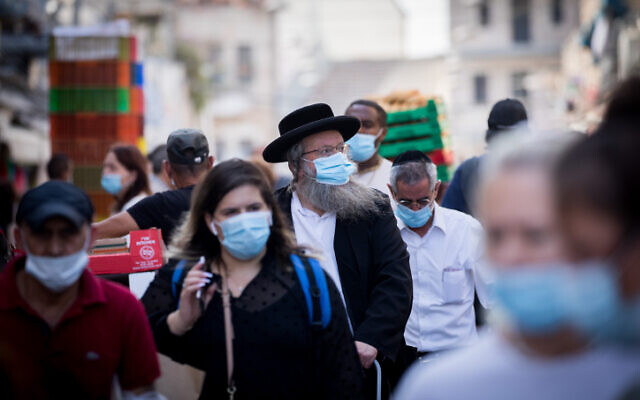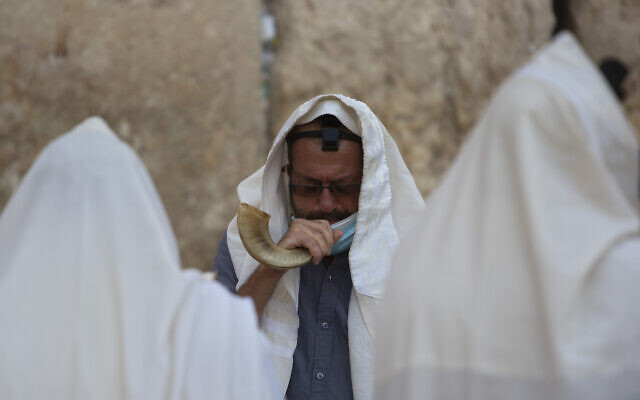Israel’s new national coronavirus lockdown, the country’s second this year, entered into effect Friday at 2 p.m., marking the first time in the world an advanced country has imposed a repeat closure to curb the pandemic.
The three-week shutdown, requiring the closure of many businesses and setting strict limits on movement and public gatherings, starts just hours before Rosh Hashana, the Jewish New Year, and will extend through other key religious holidays, including Yom Kippur and Sukkot.
Some 7,000 policemen and soldiers, backed up by local municipality personnel, were to deploy throughout the country to enforce the closure using roadblocks and patrols, amid concerns that an exhausted and exasperated Israeli public will be far less cooperative with the new sweeping restrictions than during the initial wave of the pandemic.
Fines for individuals who break rules are set at NIS 500 ($145) and for businesses at NIS 5,000 ($1,450).
בדרך לירושלים: שוטרים עוצרים כלי רכב ומתשאלים נהגים@SuleimanMas1 pic.twitter.com/EuuQ3WbKmy
— כאן חדשות (@kann_news) September 18, 2020
Meanwhile, the new lockdown is simultaneously more permissive and more complex than the weeks-long closure imposed earlier this year, with numerous directives and exceptions to those directives seeming to cause public confusion as to what is and isn’t in fact allowed.
Erez Berenbaum, director of Assuta hospital in the coastal city of Ashdod, said the “lack of clarity in the instructions will lead to defiance among Israelis.”
Read: A guide to Israel’s new national lockdown
Under the new lockdown, nearly all businesses open to the public will be closed. People must remain within 1 kilometer (0.6 miles) of home, but there are numerous exceptions, including shopping for food or medicine, going to work, attending protests and even seeking essential pet care. The public is also allowed to attend funerals or circumcision ceremonies, to exercise and more — all under strict limitations.

Policemen set up barriers to traffic at a checkpoint in Jerusalem on September 18, 2020, to enforce a new lockdown amid the COVID-19 pandemic (Ahmad GHARABLI / AFP)
On the eve of the lockdown, authorities were still deciding on the details, with a rule ordering residents to stay within 500 meters of their homes extended late on Thursday to one kilometer. During the first lockdown, the limit was set at 100 meters.
Videos posted online shortly after the lockdown came into effect showed policemen questioning drivers near Jerusalem and instructing Tel Aviv beachgoers to clear out.
הסגר החל: שוטרים מפנים אזרחים מחוף הים בתל אביב@hadasgrinberg pic.twitter.com/sLlSrOxhS8
— כאן חדשות (@kann_news) September 18, 2020
Prime Minister Benjamin Netanyahu said ahead of the closure that the government had been left with no choice but to impose a lockdown.
“The health system has raised the red flag… We did everything we could to strike a balance between the health needs and needs of the economy,” he said in a televised address on Thursday.

Prime Minister Benjamin Netanyahu at a school in Jerusalem ahead of the opening of the school year, August 25, 2020. (Marc Israel Sellem/Pool/AFP)
While the government was praised for its initial handling of the pandemic, implementing a strict lockdown in March, many Israelis have expressed frustration at the cabinet’s perceived mismanagement of the health crisis in recent months.
“This is no way to close a country,” ran a headline in the top-selling daily Yedioth Ahronoth on Friday, which featured interviews with doctors, economists and teachers all opposed to the lockdown.
Israel is the first advanced country to impose a second lockdown, though many Western nations have seen a new surge of virus cases in recent weeks, and some are considering fresh restrictions.
Ahead of the start of the lockdown, the Health Ministry released data showing that infection rates remained sky-high for Israel’s population size, with 5,238 cases identified Thursday — keeping the country near the top of the global list of daily infections per capita.
The figure is far higher than the 1,000 daily cases the Health Ministry is aiming for before it will consider lifting some of the lockdown measures, which will see movement restricted, leisure sites closed and the education system shuttered, among other limitations.

People wearing face masks shop at the Mahane Yehuda Market in Jerusalem on September 18, 2020 (Yonatan Sindel/Flash90)
Netanyahu warned Thursday that “there may be no choice but to tighten the restrictions” further.
He urged the public: “Wear masks and avoid gatherings.”
“The more this is done, the less there is a need for stringent measures,” Netanyahu said. “Those two steps are more important than any measures we impose.”
Financial and social fallout
Bars were packed in Tel Aviv and Jerusalem on Thursday evening.
The government has branded numerous cities “red” for their high infection rates, including Netanya and Rishon Lezion, near Tel Aviv, and various neighborhoods of Jerusalem, including the Old City.
Although economic activity usually slows during the Jewish high holidays, many in Israel fear the financial fallout of the second lockdown.
Netanyahu’s government had tried various measures in recent months to avoid a full shutdown, such as weekend closures, but has repeatedly backtracked in the face of opposition.
Earlier this month, the coalition attempted to impose localized lockdowns in places with high infection rates, only to downgrade the measure to curfews and school closures after facing major pushback.
Netanyahu has faced weeks of public protests against his leadership and on Thursday hundreds of Israelis rallied in Tel Aviv against the second lockdown.

Israelis protest against Prime Minister Benjamin Netanyahu at Habima Square in Tel Aviv on September 17, 2020. (Miriam Alster/Flash90)
“The economy is in free-fall, people are losing their jobs, they’re depressed,” said protester Yael, 60, who lost her job at an architecture firm in the crisis. “And all this for what? For nothing!”
The new restrictions have faced widespread opposition by the public: from religious and ultra-Orthodox Jews, because they will impact public prayer services during the High Holidays; from business owners, because of the loss in trade; and from the general public, because the closure of the education system will force many parents to miss work as they stay home to care for young children.
Critics have blamed government mismanagement and petty politics for the raging pandemic, pointing to the government’s too-swift reopening of the country in May, its failure to set up efficient contact tracing measures, its reluctance to shut down infection-heavy locales earlier in the summer and haphazard, ever-changing and often confusing public guidelines.
Reports have proliferated in recent days that health officials are doubtful the three-week lockdown will significantly bring down infections, and Health Minister Yuli Edelstein admitted Thursday that it would not be enough to stem the latest outbreak, though he hoped it would at least stop the rate of increase.
There has been concern that the government could encounter widespread resistance and rebellion against the new measures, both by members of the public who have lost trust in policies and may ignore the restrictions, and by small businesses that have suffered financially and fear they will not survive a new closure.

An ultra-Orthodox Jewish man blows a shofar as he prays ahead of the Jewish New Year at the Western Wall in Jerusalem’s old city, Wednesday, Sept. 16, 2020 (AP Photo/Sebastian Scheiner)
Ever-rising infection rates
On Friday morning the country’s total coronavirus tally stood at 176,933, of which 46,370 were active cases. The previous day’s case count stood at 5,238, continuing the trend of around 5,000 cases per day over the past week.
Patients included 577 in serious condition (153 of whom were in ventilators) and 240 in moderate condition.
The death toll stood at 1,169, with no new deaths recorded since Thursday night.
Of the 55,697 tests analyzed Thursday, 9.4 percent came back positive.
The lockdown is the first element of the government’s three-part strategy: It is expected to last three weeks at least, dependent on situational assessments, and to be followed by several weeks of somewhat eased restrictions (including freer travel within cities but not between them, allowance of gatherings of up to 50 people, grater numbers allowed at workplaces) and finally a return to the so-called “traffic light” model in which cities will be dealt with based on infection rates.
 RSS Feed
RSS Feed















 September 18th, 2020
September 18th, 2020  Awake Goy
Awake Goy  Posted in
Posted in  Tags:
Tags: 













